IP CHARLO Week
Here is a little about the IP and what we did in Estonia 2024
THE WEEK & IP – AN OVERVIEW
IP Charlo
The main objective of IP (CHARLO) is to educate and involve students in concrete work with sustainability and community resilience in the different regions across our Nordic-Baltic consortia. At the same time this strengthens networking and learning between HE and companies in the selected region.
Read more about IP Charlo
The project aims at being a change agent to help communities and business communities to tackle the challenges of sustainability, i.e. circularity and social aspects. This project is crucial for developing rural areas not only capital regions, strategic – long term development of remote areas. Some examples:
- Invitation of a local enterprise as a guest lecturer to present their story in circular economy
- Visits to local companies for exchange of experience, knowledge and know-how. Enterprises will be asked to share challenges they face and the IP team sets to find solutions for them, co-work with the enterprises
- Encourage knowledge and competence transfer into careers and further actions of the community and companies involved.
The main practical approach is collaboration between students in games and digital circular canvas models (https://circulab.com/toolbox-circular-economy/circular-canvas-regenerative-business-models/ ). By using circular canvas students learn how to express the circular solutions/ ideas in a short and effective way.
- Development through gaming as a new methodology where both students and teachers have the possibility to learn together.
- Staying in a local community for the week
- Guest lectures from local entrepreneurs or area
- Hybrid sessions to kick off the pre-tasks in the different HEIs
The learning outcomes for the students are three fold and include the development of knowledge, practice and attitudes mainly are:
- learning about SGDs and sustainability (theory, knowledge), and how to put the SGDs into action (https://sdgs.un.org/goals)
- learning by getting familiar with best practices and challenges in the local community
- learning of new tools for working with sustainability in the community (in companies and other institutions)/ learn the models of application of circular and social economy for sustainable business development in local communities and its relevance for the participating institutions
- learning how to use the business model canvas, particularly business model canvas for introduction of circularity solutions.
- introducing and sharing ideas for sustainable development in local community
- learning how to critically analyse the context
- working with openness and creativity to find new robust solutions for the community
- developing their analytical skills, sustainable thinking as well as practices related to a business context.
SUNDAY
Day 1: An Unforgettable Start to the IP Charlo Study Trip in Estonia
Day 1 Sunday
As the sun began to set on the picturesque city of Tallinn, Estonia, we, team #1, alongside students and teachers from Finland, Estonia, Iceland, Åland, Sweden, and Norway, embarked on an exhilarating week-long journey dedicated to exploring the circular economy and collaborating with an Estonian company.
Read more about our day
Day 1 Sunday
Our adventure began at the TTK University of Applied Sciences, nestled in the heart of Tallinn, where anticipation and excitement filled the air.
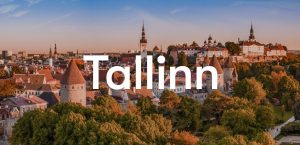
Figure 1 Photo from Tallink (https://en.tallink.com/estonia-tallinn)
The evening kicked off in rooms A321 and A322 on the third floor, where we were greeted by the amiable Britt Petjärv, Head of the Center for Humanities and Economics, along with the dedicated team of IP-CHARLO. The atmosphere was electric, charged with the promise of new friendships, learning, and discovery.
 Students were divided into groups of five and the first task was to bond with our newfound team members. In a lively and engaging session, we delved into our backgrounds, searching for commonalities, and celebrating our differences. Each group wrote down 3 things that all team members have in common, and each team member also wrote down 1 individualistic or unique talent about themselves. Each group then presented their results. This shared passion was a vivid reminder of the diversity and unity within our group. Individual talents and quirks, from the ability to touch one’s nose with their tongue to a flair for acting, added a personal touch to the introductions, highlighting the unique blend of personalities that make up our team.
Students were divided into groups of five and the first task was to bond with our newfound team members. In a lively and engaging session, we delved into our backgrounds, searching for commonalities, and celebrating our differences. Each group wrote down 3 things that all team members have in common, and each team member also wrote down 1 individualistic or unique talent about themselves. Each group then presented their results. This shared passion was a vivid reminder of the diversity and unity within our group. Individual talents and quirks, from the ability to touch one’s nose with their tongue to a flair for acting, added a personal touch to the introductions, highlighting the unique blend of personalities that make up our team.
The highlight of the evening was undoubtedly the cultural welcome activity featuring Savijalakesed, TTK UAS’s folk dance group. Their performance was a captivating display of Estonian culture, with intricate dances and traditional music that transported us into the heart of Estonia’s rich heritage. The inclusion of audience participation transformed the show into an interactive experience, allowing us to not just observe but be a part of the cultural tapestry.
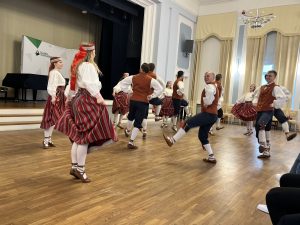
Figure 3 Savijalakesed, TTK UAS’s folk dance group
The day’s events culminated in a pizza party, providing us with the perfect opportunity to mingle and forge deeper connections with our peers from across the globe. Laughter and conversations filled the room, as we shared our thoughts and expectations for the week ahead.
As we retired to the Hotel Kreutzwald for the night, the excitement for the upcoming week was palpable. With a focus on the circular economy and the prospect of working alongside an Estonian company, we are eager to immerse ourselves in this learning experience, guided by the principles of sustainability and innovation.
Stay tuned to this study weeks’ blog for daily updates, insights, and more as we navigate through this incredible journey of learning, discovery, and cross-cultural collaboration.
Team #1: Alvilde, Asama, Dedik, Helga & Monika
#IPCharloEstonia #CircularEconomy #TeamBuilding #CulturalExchange #StudyTrip2024
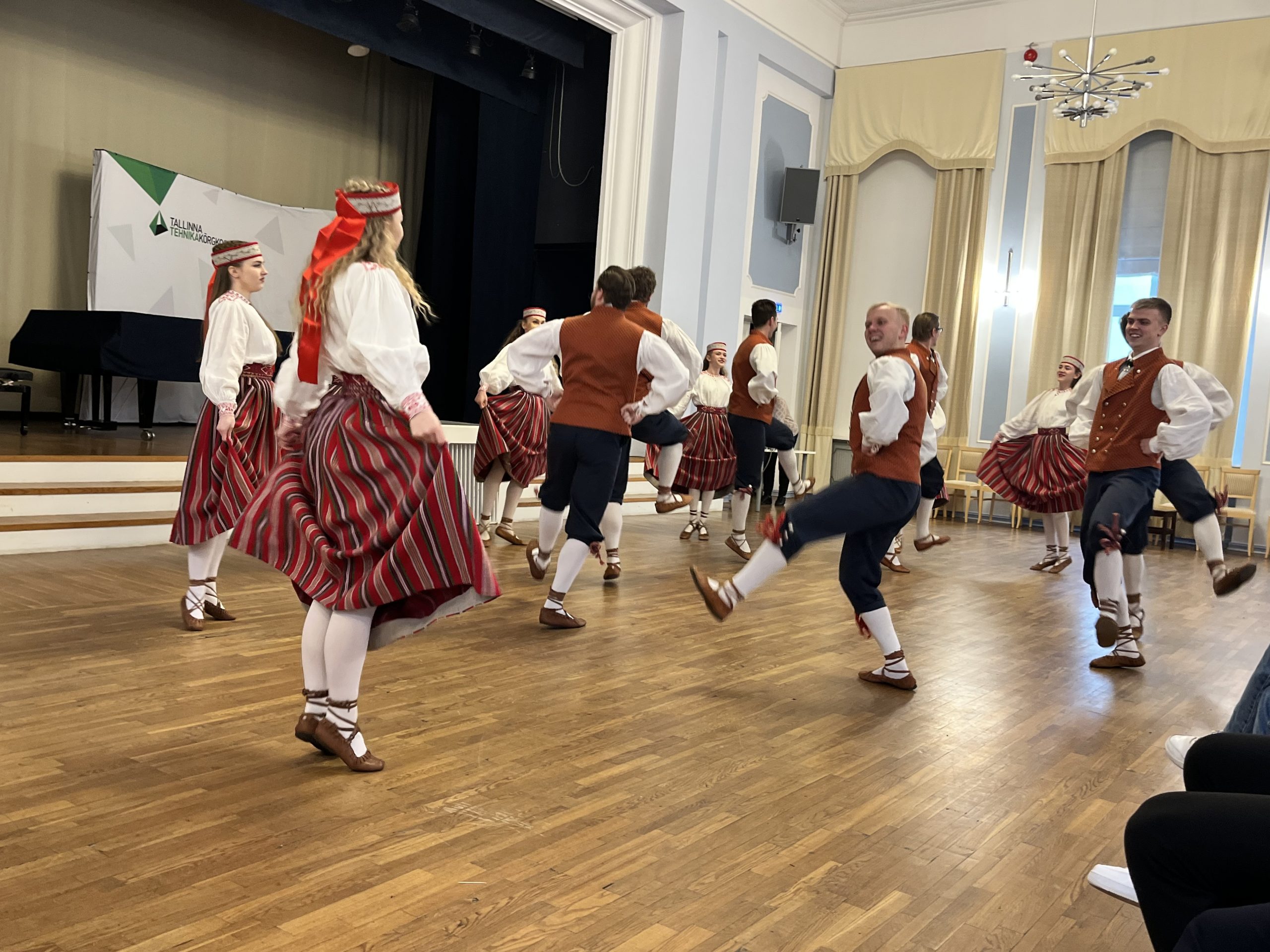
MONDAY
Day 2 - First full day, all hands on deck.
Day 2 Monday
The first day in the IP Charlo project was in Tallinn and started of course with breakfast served at the Kreutzwald Hotel Tallinn. After breakfast we got our steps in by walking to TTK with all our stuff ( workout of the day), our program was set at the TTK in a big classroom.
Read more about our day
Day 2 Monday

The day started with a wake up task from our teachers. The night before we were divided into groups and given a project that we worked on that evening. The wakeup -task was to go over our project from the night before and meet one group from Sweden that was not able to be there last night.
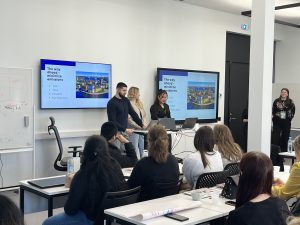
The first lecturer introduced us to the canvas and about sustainability. Karin Lindroos, a lecturer from TTK UAS gave us a presentation about the principles of Circular Economy.
Circular economy taught us how reusing waste or recycled material helps not only the life of production businesses but also everybody’s around. The main problems in this are scarce resources, pollution and ecosystem imbalance. To achieve sustainable development it is necessary to balance society, environment and economy.
80% of products fail at first, so it was important to figure out why. John Greene talked about Jake Knapp and how he used the “Sprint’s” method to gain success and how to solve big problems and new ideas in just five days. Jake figured that it’s way better to allow people to figure out if an idea would work and what challenges might come but just in a faster way.
Next up was Evelin Vaab, the Director of the Institute of Engineering and Circular Economy. Evelin talked about Green Balance. During the class we were taught about the problems of fast fashion. The teacher gave us a perspective where we as a society are stuck in the ways that are marketed to us. A good example was why micro trends are so bad in this economy. We weighed the different approaches a company can take to improve their strategy on sustainability.
Last project of the day was our group presentation. Every school had prepared a presentation about the circular economy from their country ́s clothing shops .
The presentations were interesting, and gave us a good insight into their circular economy.
After the presentations were finished, we took our stuff to the bus and we were off to Tartu.
Team 2 – Maríanna Margeirsdóttir, Deivile Karazijaite, Gowsigan Ravichandran, Emilie Arkko, Randolf Stamm

TUESDAY
Day 3 It's a fabulous sunny morning in Tartu,
Day 3 Tuesday
We indulged in a delightful breakfast before making our way to Tartu Health Care College.
Read more about our day
Day 3 Tuesday
Navigating our route to the college was a challenge yet proved to be an enjoyable effort as some among us opted to walk, while others called a taxi or chose public transportation. Despite the different chosen modes of transportation, we all arrived punctually, with lots of enthusiasm to commence our day.
The wake-up task was an interesting exercise that the teachers had thought for us. We had to form a circle and count to 20 in our five-person groups. One number was for one person at a time. For example: if two people said the “number 12” at the same time, you had to start over. We also watched a very inspiring TV ad “All That We Share.” It talked about how different people are not as different as we think. It wasn’t a bad wake-up task, but we hope that maybe tomorrow there will be something physical.
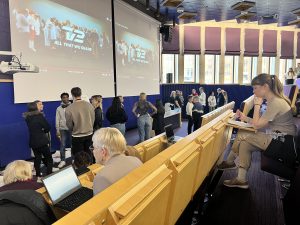
Next in line is the process of design thinking and mindset preparation. We were instructed to learn and ask some questions about the company Disaintekstiil Oü who’s problem we are going to solve. It was more of a brainstorming with different ideas.
Kairi Palm, the Production and Sustainability Manager of Disaintekstiil Oü conducted a comprehensive overview of the case company. She elaborated on the company’s mission, operational procedures, functionalities, and their journey towards sustainability.
Following the presentation, an interactive question and answer session provided an opportunity to address various inquiries and grey areas. This session proved to be a very useful preparation for the lined-up client visit. Students had the opportunity to visit the factory in smaller groups and gain real-time experience of its operations.
We have breaks for lunch, and the dessert after each meal is very luxurious!!
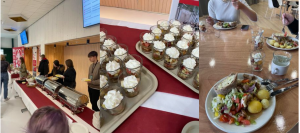
The client visits and works in groups
The staff at Moomoo warmly welcomed us with smiles and guided us through their operations. Ms. Kairi graciously supported us by leading us to each processing station and providing explanations of their operations.
First, we took a glimpse at the cutting table where a machine utilized recycled plastic and effortlessly cut out various pieces of clothing. Next, we proceeded to the colouring station to observe the printing process. There, Kairi graciously showed us a sample print to demonstrate the colour differences displayed on the screen and on the actual fabric. After exploring the colouring station, we made our way to the sewing area where skilled seamstresses expertly assembled the various parts of the garments. With precision and finesse, they patched the garments together and ironed them, preparing them for sale. Moving on to the next station, we observed the packaging process, marveling at the use of sustainable materials. Finally, as our last stop, we visited the shop where they are currently retailing their sportswear, although plans for expansion and the opening of additional shops were underway.

It was truly fascinating to witness firsthand and learn about their production processes. This experience will undoubtedly be invaluable as we transition into our professional careers, enabling us to gain a deeper understanding of business operations and address challenges more efficiently. We observed how an example
SME, like Disaintekstiil Oü manages their brand «Moomoo»operations. From production to packaging and shipping, under the same roof. This gives us inspiration on how we maybe could run our own enterprises someday in the future and the practical implications.
Our next task was to continue the discussion with our group members and identify areas for improvement in Moomoo for circularity.
It was a long day, we all met at the main hall and summarised the task. It was a free evening for us and we look forward to having some fun.
Team 3 – Natalie Polivkova, Anna Wicknertz, Evija, Salomi Judith and Egert Starkopf
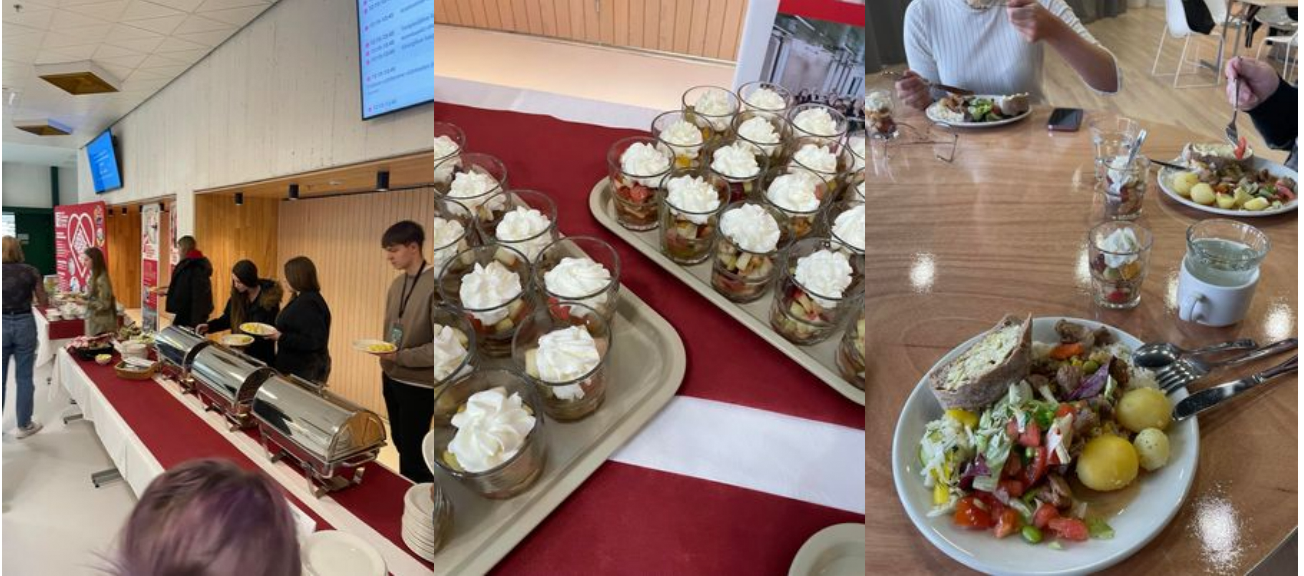
WEDNESDAY
Day 4: Busy at work!
Day 4 Wednesday
The fourth day in Estonia started with something pretty cool – did you know that the brand name of the moomoo cycling clothing comes from KLF’s song Justified & Ancient?
Read more about our day
Day 4 Wednesday
Well, we watched the music video, did a little morning exercise, and then we were ready to start the day!
Our first topic was about Human Resource Management (HRM), specifically from the sustainability standpoint, which our lecturer Laima skillfully explained. We learned that it’s not enough to have good intentions; it’s about making those intentions come to life, which was truly inspiring. After all, when employees are feeling happy, they become engaged. And when they are engaged, they become brand ambassadors that boost the company forward. One thing to highlight from the lecture was the AMO model, which refers to Ability, Motivation and Opportunity. It simplifies what the employees need to succeed at their tasks at work. …though, to be brutally honest, we all know we needed that quick wake-up call when Laima slammed her fist to the table (with the best of intentions, of course!).

Oh, and let’s not forget about lunch — it was amazing! The delicious food fueled us up and prepared us to tackle the rest of the day with ease. And yes, the bread deserves a special shout-out. It was clearly freshly baked, and we all agreed that it had the perfect texture – thanks to the chef!
After lunch, we had a session on Key Performance Indicators (KPIs) with Lester, and let me tell you, it was anything but boring. He used excellent examples during his explanation and activated the audience with his thoughtful questions, making sure we were on the same page with him on every step of the way. We also dove into the Year-To-Date (YTD) analysis, which in simple terms means looking back at what you’ve done so far this year, compared to the same period from the previous year, to help you figure out your next moves. It’s like taking a quick glance in the rearview mirror before speeding ahead. Then, Lester told us about maturity models, which help you understand how far away you are from your goal based on pre-set qualifications. For example, to be mature, one would need to get a wife and a kid, among other things.
We wrapped up the day by splitting into teams to work on our value chain canvas, partner map, and problem matrix, with the help of the teachers, including Jan and John who told us more about Sprint in project management. Doing it at the end of the day worked really well, as we got to apply everything we had learned throughout the day in a more relaxed, casual setting. It was all about teamwork, throwing around ideas, and figuring out how to tackle problems together. There was a lot of laughter, some head-scratching moments, but most importantly, a sense of achievement.
Looking back, it was a day filled with learning, good food, and great company. The CHARLO project isn’t just another course on our curriculums; it’s about learning the importance of sustainability in business and how to bring out the best in each other, congratulating our individual strengths and offering help when facing difficulties.
Team #4: Fausta, Ketill, Marissa, Maximilian, Sandra (and Jon)

THURSDAY
Half Day blog - Thursday
Day 5 Thursday
We started out the day by going through the schedule for the day and which rooms were available for us. Then after that we uploaded our personality test results that we did yesterday on 16personalities.com.
Read more about our day
Day 4 Thursday
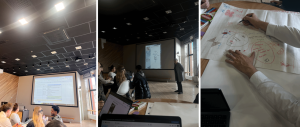
It was interesting to see what everyone in IP Charlo had for personalities and to get an overview of everyone. We learned that most people are extroverts and get energy by spending time with others and that we need different types of personalities for a group to work out. We also wrote everyone’s results on our flower and learned that we have three introverts and two extroverts. By learning other group members’ personalities we can also understand each other better and use our skills more efficiently when we are trying to solve problems and why different people feel a certain way.
9:15
At 9:15, we were privileged to have Kadri Kalle, an environmental expert and trainer, as our guest lecturer. The lecture’s subject was “Greenwashing to truly sustainable solutions’’. Kalle started out by asking the students what they wanted to know about the subject and everyone wanted to know for example what it is and some examples of greenwashing.
In our group workshops, we were tasked with discussing three key examples: those that are environmentally friendly, instances of greenwashing, and situations where it might be unclear whether or not something constitutes greenwashing.
Examples of Greenwashing from the groups
After a refreshing coffee break, our focus shifted towards a more hands-on approach, as we had the opportunity to consult with our client directly, diving deep into our project work. This session was pivotal for our team, as it enabled us to apply our accumulated knowledge and skills in a real-world context, bringing us closer to achieving our project goals.

The afternoon provided us a brief respite with lunch at Tartu HCC, where we were also treated to ice cream for dessert. This was not only a chance to recharge but also provided a moment to reflect on the morning’s activities and strategize for the upcoming presentation that all students have meticulously been working on throughout the week.
Team #7: Ebba, Gabrielė, Osman, Saad & Sandra
#IPCharloEstonia #CircularEconomy #TeamBuilding #CulturalExchange #StudyTrip2024
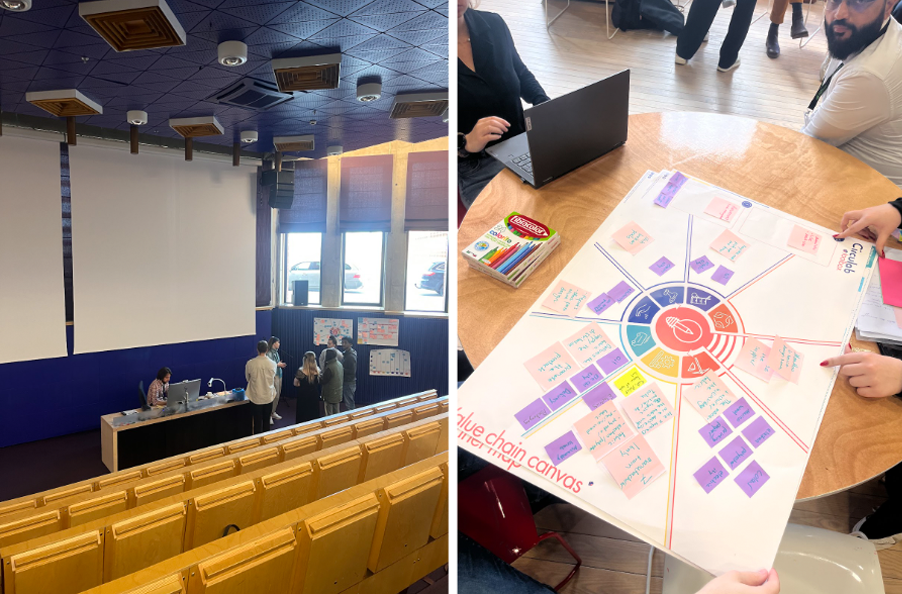
FRIDAY
